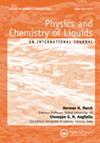Gigapascal压力范围内MgCl2水溶液的x射线和中子散射研究
IF 1.2
4区 化学
Q4 CHEMISTRY, PHYSICAL
引用次数: 1
摘要
在分子水平上,电解质溶液在压力下的结构是理解离子溶剂化和缔合性质的基础科学和应用领域的关键问题,如地球上的地质过程、压力诱导的蛋白质变性和超临界水技术。本文报道了一种2 m (=mol kg−1)MgCl2水溶液在压力为0.1 MPa ~ 4gpa、温度为300 ~ 500 K时的结构。利用经验势结构精化(EPSR)模型对散射数据进行分析,得到了三维结构的对分布函数、配位数分布、角度分布和空间密度函数随压力和温度的变化规律。Mg2+形成延伸至第三壳层的刚性溶剂化壳层;在GPa压力范围内,由于接触离子对的形成,由6个水分子组成的六重八面体配位的第一溶剂化壳转变为5个水分子和1个Cl−。Cl -溶剂化表现出明显的压力依赖性;在0.1 MPa/300 K时Cl−周围的水氧配位数为8,在4 GPa/500 K时为10。溶剂水在0.1 MPa/300 K时由四面体网状结构转变为GPa压力范围内的密排结构;中心水分子周围的水氧原子数逐渐增加,从0.1 MPa/298 K时的4.6个增加到4 GPa/500 K时的8.4个。本文章由计算机程序翻译,如有差异,请以英文原文为准。
An X-ray and Neutron Scattering Study of Aqueous MgCl2 Solution in the Gigapascal Pressure Range
The structure of electrolyte solutions under pressure at a molecular level is a crucial issue in the fundamental science of understanding the nature of ion solvation and association and application fields, such as geological processes on the Earth, pressure-induced protein denaturation, and supercritical water technology. We report the structure of an aqueous 2 m (=mol kg−1) MgCl2 solution at pressures from 0.1 MPa to 4 GPa and temperatures from 300 to 500 K revealed by X-ray- and neutron-scattering measurements. The scattering data are analyzed by empirical potential structure refinement (EPSR) modeling to derive the pair distribution functions, coordination number distributions, angle distributions, and spatial density functions (3D structure) as a function of pressure and temperature. Mg2+ forms rigid solvation shells extended to the third shell; the first solvation shell of six-fold octahedral coordination with about six water molecules at 0 GPa transforms into about five water molecules and one Cl− due to the formation of the contact ion pairs in the GPa pressure range. The Cl− solvation shows a substantial pressure dependence; the coordination number of a water oxygen atom around Cl− increases from 8 at 0.1 MPa/300 K to 10 at 4 GPa/500 K. The solvent water transforms the tetrahedral network structure at 0.1 MPa/300 K to a densely packed structure in the GPa pressure range; the number of water oxygen atoms around a central water molecule gradually increases from 4.6 at 0.1 MPa/298 K to 8.4 at 4 GPa/500 K.
求助全文
通过发布文献求助,成功后即可免费获取论文全文。
去求助
来源期刊

Physics and Chemistry of Liquids
化学-物理:凝聚态物理
CiteScore
3.30
自引率
8.30%
发文量
43
审稿时长
6-12 weeks
期刊介绍:
Physics and Chemistry of Liquids publishes experimental and theoretical papers, letters and reviews aimed at furthering the understanding of the liquid state. The coverage embraces the whole spectrum of liquids, from simple monatomic liquids and their mixtures, through charged liquids (e.g. ionic melts, liquid metals and their alloys, ions in aqueous solution, and metal-electrolyte systems) to molecular liquids of all kinds. It also covers quantum fluids and superfluids, such as Fermi and non-Fermi liquids, superconductors, Bose-Einstein condensates, correlated electron or spin assemblies.
By publishing papers on physical aspects of the liquid state as well as those with a mainly chemical focus, Physics and Chemistry of Liquids provides a medium for the publication of interdisciplinary papers on liquids serving its broad international readership of physicists and chemists.
 求助内容:
求助内容: 应助结果提醒方式:
应助结果提醒方式:


